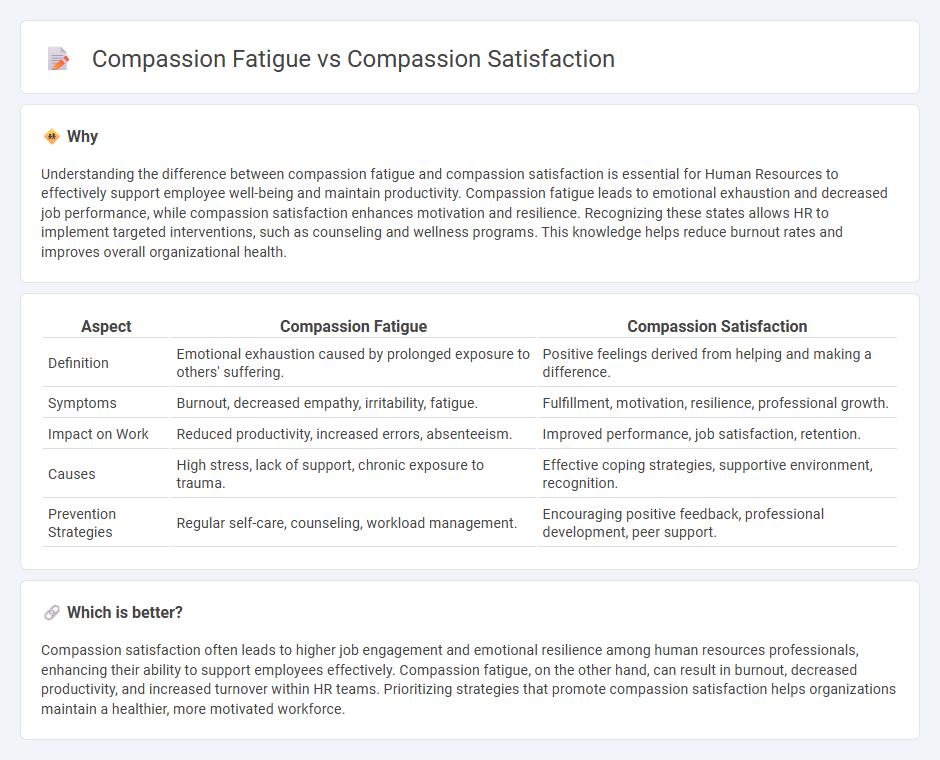
Compassion fatigue occurs when caregivers experience emotional exhaustion and reduced empathy from prolonged exposure to others' suffering, leading to burnout and decreased job performance. In contrast, compassion satisfaction arises from the fulfillment and positive feelings gained through helping others, promoting resilience and job satisfaction in human resources professionals. Explore effective strategies to balance compassion fatigue and compassion satisfaction for sustainable workplace wellbeing.
Why it is important
Understanding the difference between compassion fatigue and compassion satisfaction is essential for Human Resources to effectively support employee well-being and maintain productivity. Compassion fatigue leads to emotional exhaustion and decreased job performance, while compassion satisfaction enhances motivation and resilience. Recognizing these states allows HR to implement targeted interventions, such as counseling and wellness programs. This knowledge helps reduce burnout rates and improves overall organizational health.
Comparison Table
| Aspect | Compassion Fatigue | Compassion Satisfaction |
|---|---|---|
| Definition | Emotional exhaustion caused by prolonged exposure to others' suffering. | Positive feelings derived from helping and making a difference. |
| Symptoms | Burnout, decreased empathy, irritability, fatigue. | Fulfillment, motivation, resilience, professional growth. |
| Impact on Work | Reduced productivity, increased errors, absenteeism. | Improved performance, job satisfaction, retention. |
| Causes | High stress, lack of support, chronic exposure to trauma. | Effective coping strategies, supportive environment, recognition. |
| Prevention Strategies | Regular self-care, counseling, workload management. | Encouraging positive feedback, professional development, peer support. |
Which is better?
Compassion satisfaction often leads to higher job engagement and emotional resilience among human resources professionals, enhancing their ability to support employees effectively. Compassion fatigue, on the other hand, can result in burnout, decreased productivity, and increased turnover within HR teams. Prioritizing strategies that promote compassion satisfaction helps organizations maintain a healthier, more motivated workforce.
Connection
Compassion fatigue and compassion satisfaction are interconnected aspects of caregiving roles in Human Resources, where prolonged exposure to employee stress can lead to emotional exhaustion. Employees and HR professionals experiencing greater compassion satisfaction often demonstrate higher resilience against compassion fatigue, promoting improved workplace well-being. Balancing support systems and employee recognition enhances overall organizational health by mitigating compassion fatigue while fostering compassion satisfaction.
Key Terms
Burnout
Compassion satisfaction refers to the positive feelings derived from helping others, which enhances emotional resilience among healthcare professionals, while compassion fatigue is a state of emotional exhaustion and reduced capacity for empathy, often leading to burnout characterized by chronic stress and decreased job performance. Burnout, a significant component of compassion fatigue, manifests as physical and mental depletion, detachment, and a sense of ineffectiveness among caregivers. Explore effective strategies and interventions to manage compassion fatigue and prevent burnout for improved well-being and professional longevity.
Empathy
Compassion satisfaction refers to the fulfillment and positive feelings derived from helping others, driven by genuine empathy and emotional connection with those in need. Compassion fatigue, in contrast, results from prolonged exposure to suffering, leading to emotional exhaustion and decreased empathy. Explore how balancing empathy can enhance compassion satisfaction while preventing compassion fatigue for sustained emotional well-being.
Resilience
Compassion satisfaction refers to the positive feelings derived from helping others, which enhances emotional resilience and job fulfillment in caregiving professions, whereas compassion fatigue involves emotional exhaustion and decreased empathy due to chronic exposure to others' suffering. Building resilience through mindfulness, self-care, and supportive work environments mitigates compassion fatigue and promotes sustained compassion satisfaction. Explore effective strategies to strengthen resilience and balance compassion satisfaction against compassion fatigue for career longevity.
Source and External Links
Fostering Compassion Satisfaction through Holistic Self-Care - Compassion satisfaction is the positive feeling derived from helping others that motivates and sustains professionals, reduces burnout, and includes actionable self-care behaviors such as regulated sleep and ongoing training.
What is Compassion Satisfaction and How Can it Help? - Compassion satisfaction is the rewarding sense of fulfillment that comes from helping others and is considered the antidote to compassion fatigue in caregiving professions.
Compassion Satisfaction, Burnout, and Secondary Traumatic Stress ... - Greater professional experience, job satisfaction, and social support enhance compassion satisfaction, which can mitigate burnout and secondary traumatic stress among healthcare workers.
 dowidth.com
dowidth.com